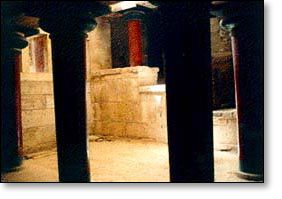Labyrinth (LAB-i-rinth). A fiendishly intricate maze devised by Daedalus to house the Minotaur. The myth of an impossibly complex series of corridors may have been inspired by travelers' tales of the historical palace or temple compound of Knossos.
 The name "Labyrinth" comes from the word "labrys" meaning "double-ax", and the dynasty of King Minos was referred to as the "House of the Double-Ax". Clearly there is history behind the myth here, for many images of double-axes have been found by archaeologists on Crete from a time even earlier than that of the mythological heroes.
The name "Labyrinth" comes from the word "labrys" meaning "double-ax", and the dynasty of King Minos was referred to as the "House of the Double-Ax". Clearly there is history behind the myth here, for many images of double-axes have been found by archaeologists on Crete from a time even earlier than that of the mythological heroes.
 But such images are far older still, being found on European icons from as long ago as 5000 B.C.E. And before they became stylized as double-headed axes with curved blades, it is clear that they depicted butterflies. Because of its transformation from a caterpillar, the butterfly represented change and rebirth to the people of the Stone Age, and therefore it was revered as a form of the Great Goddess.
But such images are far older still, being found on European icons from as long ago as 5000 B.C.E. And before they became stylized as double-headed axes with curved blades, it is clear that they depicted butterflies. Because of its transformation from a caterpillar, the butterfly represented change and rebirth to the people of the Stone Age, and therefore it was revered as a form of the Great Goddess.
 Other images of the Great Goddess in the form of a snake are characteristic of the Minoan civilization. Snakes were sacred symbols because they shed their skin and were in that sense reborn, and the rebirth of the crops and edible plants in the springtime was humankind's greatest preoccupation. So a snake might be worshipped or serve a ceremonial role, either as a symbol or an embodiment of the Goddess herself.
Other images of the Great Goddess in the form of a snake are characteristic of the Minoan civilization. Snakes were sacred symbols because they shed their skin and were in that sense reborn, and the rebirth of the crops and edible plants in the springtime was humankind's greatest preoccupation. So a snake might be worshipped or serve a ceremonial role, either as a symbol or an embodiment of the Goddess herself.
 Crete was last outpost of female-oriented religion and the point of contact between prehistoric Europe and the world of the ancient Greeks. Minoan Crete is a window through which we can look back at the spiritual roots of Europe. According to the myths, Zeus was born on Crete or sheltered there in a cave on Mount Dicte. Thus the Greeks acknowledged a more ancient spiritual heritage.
Crete was last outpost of female-oriented religion and the point of contact between prehistoric Europe and the world of the ancient Greeks. Minoan Crete is a window through which we can look back at the spiritual roots of Europe. According to the myths, Zeus was born on Crete or sheltered there in a cave on Mount Dicte. Thus the Greeks acknowledged a more ancient spiritual heritage.
|



